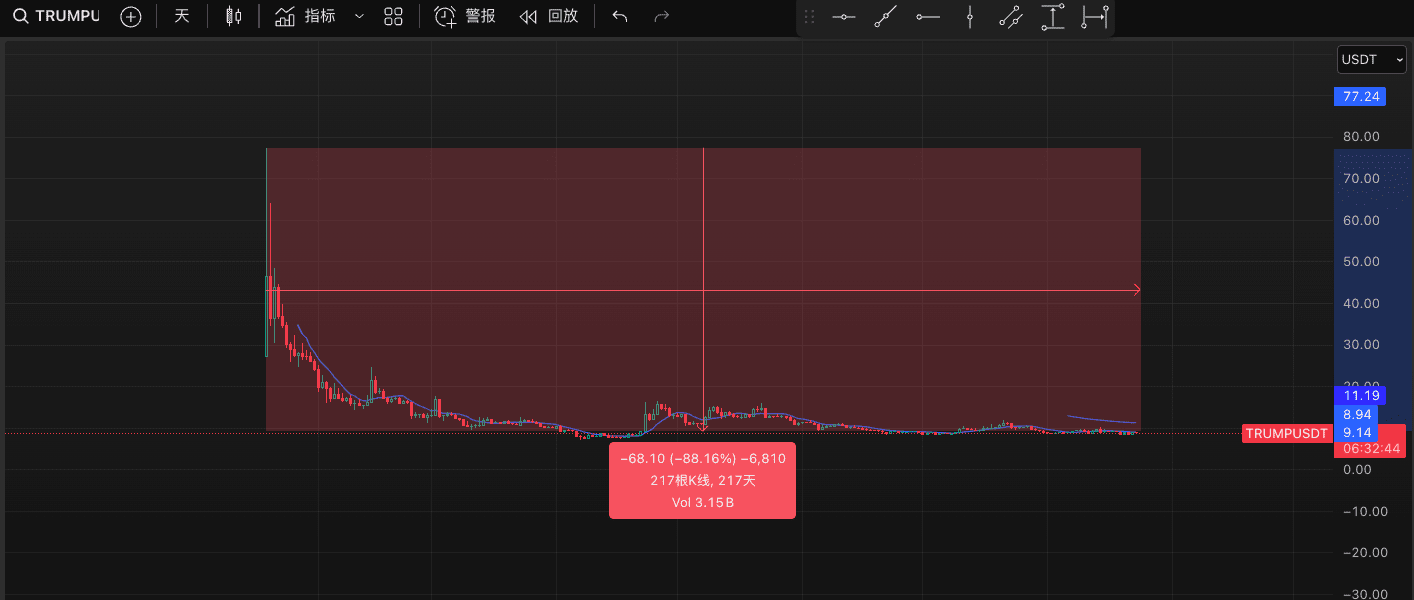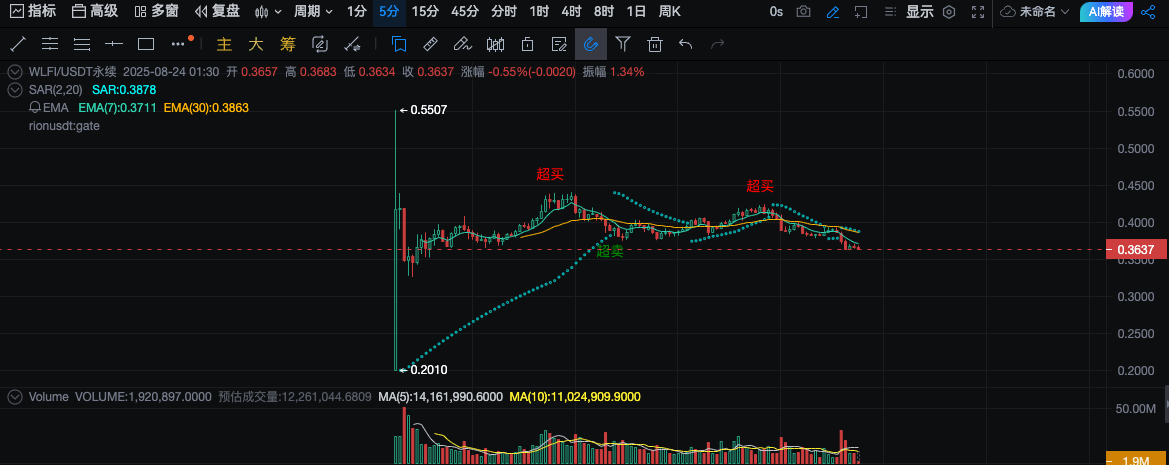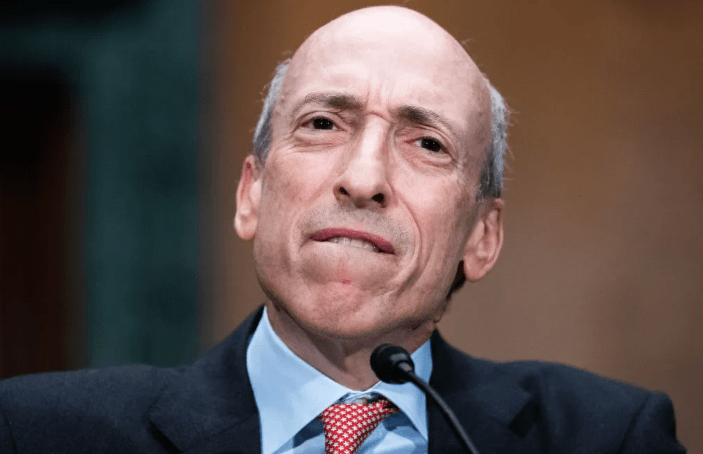Around 16:00 on August 23, Binance released an announcement that it would launch WLFIUSDT perpetual contracts, and the market's enthusiasm was ignited again.
This project, called World Liberty Financial, is certainly attracting attention with its cooperation with industry giant AAVE, but what is even more concerning is its deep connection with the US government or the Trump presidential family, and the combination of the two has triggered unprecedented discussions in the market.
After the hype wave of $TRUMP, the appearance of $WLFI cannot help but make people wonder, is this the second knife swung to the market? If so, will the feast still be paid for by retail investors? If not, can it really open a new chapter combining politics and finance?

I. Essence Analysis: The Combination of DeFi and Political Influence
To understand WLFI, one must abandon traditional classification methods, as it cannot be simply defined as a memecoin or a DeFi protocol, but a brand new "hybrid" species.
The core of WLFI is a project called World Liberty Financial, which aims to integrate US dollar-backed stablecoins with on-chain lending in a regulated framework.
The WLF protocol utilizes the technical infrastructure of Aave, the largest lending market in the DeFi space, and uses it as a licensed front-end service.
The WLFI token is the governance token of the project, initially defined as non-transferable and only used for voting on project development. However, in a community vote in July of this year, 99.94% of the votes overwhelmingly passed a proposal to change the nature of the WLFI token from a pure governance tool to a freely tradable token.
This shift has filled WLFI's value with secondary market speculation, while also legitimately giving it the attribute of a "harvesting" tool.
It is this transformation that has rapidly financialized WLFI from a seemingly serious technical project into an asset that can be traded, speculated, and even manipulated.
II. Valuation Debate: Market vs. Institution, Who is Right?
For tokens already circulating in the secondary market, their value is usually discovered through open market trading. However, before WLFI was officially launched, there was an extremely unusual valuation contradiction: the current pre-market perpetual contract price on Binance is around 0.4 (because the price is still changing rapidly, so I can only write the price at the time of writing, please keep a close eye on the dynamics of the exchange for the real market price), which is significantly higher than the institutional valuation of $0.2 US dollars determined by the listed company ALT5 Sigma in the institutional round.
Considering that pre-market trading is still in a non-fully free-flowing state, coupled with the extremely high risk of information asymmetry, any price at present does not have serious investment guidance.
The fact that Trump's son Eric and other executives of the WLF project will join the ALT5 Sigma board further highlights that the transaction and valuation are not independent, rational, and entirely based on market levels, but rather there is a clear nature of collusion of interests.
This model has spawned the freak WLFI, which seems to be more of a "Political-Financial Asset" (Politi-Fi). Its valuation logic is different from all DeFi protocols on the market because its value does not depend on any technical utility or revenue model, but more on the perceived strong political influence and the resulting political speculation potential. How to quantify and value political influence is a new issue facing the market, and it is also WLFI's most core risk, bar none.

III. Under the Deep Water: Political Intervention and Ethical Risks
The core of WLFI's differentiation from any other cryptocurrency, and also from $TRUMP, is precisely its unprecedented deep connection with American politics.
Reports indicate that Trump family entities hold as much as 60% of WLFI's equity and enjoy 75% of the token sales revenue. Trump himself has earned more than $57 million from WLFI token sales. This unprecedented model makes the line between private wealth and government policy extremely blurred. The value of the token may be directly affected by policy changes that favor the crypto industry.
This raises serious moral hazards and conflicts of interest, leading to questions about whether this is promoting industry development or using public power to benefit private projects?
The expansion of WLFI's USD1 stablecoin coinciding with the possibility of the US Treasury using stablecoin reserves to finance government debt raises serious questions about whether policy-making may be serving private interests.
Furthermore, WLFI's success is not accidental, but based on utilizing political connections for strategic financial operations. The report mentions WLFI's investment with Justin Sun & Abu Dhabi's state-owned company MGX, which has pushed the controversy to the forefront.
Critics describe this model as blurring the lines between private enterprise and government policy "in a way unprecedented in modern American history."
IV. Deadly Double Knives: $WLFI and $TRUMP Dance Together
Compared to competing with each other, the relationship between WLFI and TRMUP is more like complementing each other. WLFI's institutional investment background and DeFi attributes are more likely to attract professional investors and institutions; while TRUMP is more of a carnival for P generals. The issuance of the two tokens corresponds to two different market segments, more like carefully prepared deadly double knives.
More importantly, the high-profile launch of WLFI further completes the narrative of the "Trump Family Crypto Empire," which is likely to trigger wider attention and attract more diverse investment. Considering other projects in the crypto empire, including the family series tokens MELANIA and mining companies, if WLFI is very successful, it is likely to produce a spillover effect, making all related tokens rise in value.
V. Greater Fool Game: Crypto's Tulip Mania
The official launch date for WLFI is set for September 1, at which time 20% of the total supply, or 20 billion tokens, will enter the market.
WLFI's trajectory will be influenced by a variety of factors, including any cryptocurrency-friendly policies from the Trump administration, formal listing announcements on major centralized exchanges, and any formal investigations or indictments from the SEC or other regulatory bodies.
From a token economics perspective, although most of the tokens are locked, the huge initial tradable supply and the lack of historical price support and valuation reference mean that the token will face extreme volatility after being launched, the market's price discovery function will be completely chaotic, and violent fluctuations in any direction may occur on the first day.
Although short-term trends cannot be fully predicted, the market may be like the Dutch tulip craze of the 17th century: everyone understands that tulip bulbs are not worth that much money, but always believes that there will be a "greater fool" to take over from themselves later. After the market is extremely bubbled, there will be a crazy stampede, repeating the cycle until blood flows like a river.

VI. The Student Surpasses the Teacher: The Second Knife, But Sharper
In conclusion, the launch of WLFI is not only the second knife swung to the market after TRUMP, but also the second step in the "Trump Crypto Empire" strategy.
If TRUMP is a small knife using a political brand and personal influence to test the market, then WLFI is a more complex large knife integrating finance, DeFi concepts, and political power.
What it brings is an unprecedented deep integration of politics and finance, as well as unprecedented moral risks and market risks. For ordinary retail investors, this is an extremely dangerous financial adventure that requires high vigilance.
Nevertheless, the listing of WLFI is still a milestone event in the crypto market, as it unprecedentedly integrates politics, finance, and speculation into a single asset.
Only time will tell if this opens Pandora's Box.



